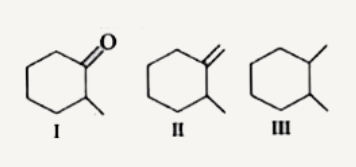The comopound which exhibits coordination isomerism is:
[Pt(NH3)2Cl2]
K3[Fe(CN)6]
K4[Fe(CN)6]
[Cr(NH3)6][Co(CN)6]
The correct Answer is:D
To determine which compound exhibits coordination isomerism from the given options, we need to understand what coordination isomerism is and analyze the compounds provided.
1. Understand Coordination Isomerism:
Coordination isomerism occurs when there are two or more isomers that have the same molecular formula but differ in the arrangement of ligands around the central metal ion. This typically involves a cationic and an anionic part in the coordination complex.
2. Identify the Given Compounds:
The compounds provided are:
- PTNH3O2I
- Cl2
- K3Fe(CN)6
- K4Fe(CN)6
- Cr(NH3)6
- Co(CN)6
3. Analyze Each Compound for Coordination Isomerism:
- PTNH3O2I: This compound does not have a clear cationic and anionic part, thus it is unlikely to exhibit coordination isomerism.
- Cl2: This is a simple diatomic molecule and does not exhibit coordination isomerism.
- K3Fe(CN)6: This is a coordination compound with a cation (K+) and an anion (Fe(CN)6)3-. It has the potential for coordination isomerism.
- K4Fe(CN)6: Similar to K3Fe(CN)6, this compound also has a cation and an anion, thus it may exhibit coordination isomerism.
- Cr(NH3)6: This is a neutral complex with no distinct cationic or anionic parts, so it does not exhibit coordination isomerism.
- Co(CN)6: This is also a neutral complex and does not exhibit coordination isomerism.
4. Conclusion:
Among the given compounds, K3Fe(CN)6 and K4Fe(CN)6 are the only ones that can exhibit coordination isomerism due to the presence of both cationic and anionic parts.
5. Final Answer:
The compound which exhibits coordination isomerism is K3Fe(CN)6 and K4Fe(CN)6.
Coordination isomerism occurs when there are two or more isomers that have the same molecular formula but differ in the arrangement of ligands around the central metal ion. This typically involves a cationic and an anionic part in the coordination complex.
The compounds provided are:
- PTNH3O2I
- Cl2
- K3Fe(CN)6
- K4Fe(CN)6
- Cr(NH3)6
- Co(CN)6
- PTNH3O2I: This compound does not have a clear cationic and anionic part, thus it is unlikely to exhibit coordination isomerism.
- Cl2: This is a simple diatomic molecule and does not exhibit coordination isomerism.
- K3Fe(CN)6: This is a coordination compound with a cation (K+) and an anion (Fe(CN)6)3-. It has the potential for coordination isomerism.
- K4Fe(CN)6: Similar to K3Fe(CN)6, this compound also has a cation and an anion, thus it may exhibit coordination isomerism.
- Cr(NH3)6: This is a neutral complex with no distinct cationic or anionic parts, so it does not exhibit coordination isomerism.
- Co(CN)6: This is also a neutral complex and does not exhibit coordination isomerism.
Among the given compounds, K3Fe(CN)6 and K4Fe(CN)6 are the only ones that can exhibit coordination isomerism due to the presence of both cationic and anionic parts.
The compound which exhibits coordination isomerism is K3Fe(CN)6 and K4Fe(CN)6.
Topper's Solved these Questions
- BOOK - ICSECHAPTER - COORDINATION COMPOUNDS EXERCISE - EXERCISE (PART - II DESCRIPTIVE QUESTIONS) (VERY SHORT ANSWER TYPE QUESTIONS)67videos
COORDINATION COMPOUNDS
- BOOK - ICSECHAPTER - COORDINATION COMPOUNDS EXERCISE - EXERCISE (PART - II DESCRIPTIVE QUESTIONS) (SHORT ANSWER QUESTIONS)74videos
COORDINATION COMPOUNDS
- BOOK - ICSECHAPTER - COORDINATION COMPOUNDS EXERCISE - EXERCISE (PART - I OBJECTIVE QUESTIONS)22videos
COORDINATION COMPOUNDS
- BOOK - ICSECHAPTER - CHEMISTRY-2020 EXERCISE - Question (Answer the following question)4videos
CHEMISTRY-2020
- BOOK - ICSECHAPTER - d- AND- f- BLOCK ELEMENTSEXERCISE - ISC EXAMINATION QUESTIONS (PART-II)(DESCRIPTIVE QUESTIONS)15videos
d- AND- f- BLOCK ELEMENTS
Similar Questions
Which among the following statement are true for the complex
[Co(NH3)6][Cr(CN)6]?
(1) It is a non electrolyte
(2) The magnitude of the charge on each complex in is 3
(3) the complex will not conduct current.
(4) The complex will exhibit coordination isomerism
(5) The magnitude of the charge on each complex ion is 1View SolutionCoordination isomerism exhibited by
View Solution
Knowledge Check
- Question 1 - Select One
The compound which exhibits linkage isomerism is :
A[Cr(NH3)6]3+B[Co(NH3)6]3+C[Co(NH3)5NO2]Cl2D[Pt(NH3)2Cl2] - Question 2 - Select One
The compound which does not exhibit optical isomerism is
ACH3CHBrCOOHBCH2ClCH2COOHCCH3CHOHCOOC2H5DCH3CHOHCOOH
An example of coordination isomerism is
View SolutionThe compound (s) the exhibit(s) geometrical isomerism is (are ) :
View Solution
Which of these compounds will exhibit geometrical isomerism?View SolutionWhich of the following compound will exhibit geometrical isomerism ?
View SolutionWhich of the following coordination compounds exhibits ionisation isomerism
(a) [Cr(NH3)6]CI3
(b) [Cr(en)3CI3]
(c ) [Cr(en)3]CI3
(d) [Co(NH3)5Br]SO4 .View SolutionWhich of the following compounds will exhibit geometrical isomerism?
View Solution

